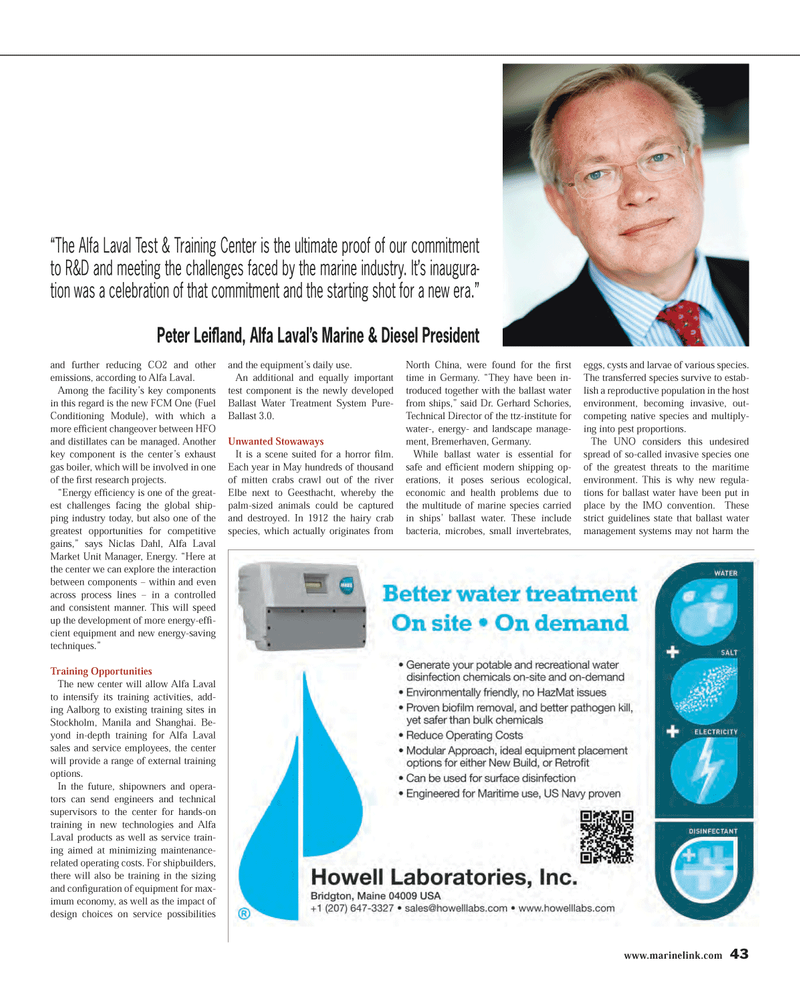
Page 43: of Maritime Reporter Magazine (February 2014)
Cruise Shipping Edition
Read this page in Pdf, Flash or Html5 edition of February 2014 Maritime Reporter Magazine
www.marinelink.com 43 and further reducing CO2 and other emissions, according to Alfa Laval.
Among the facility’s key components in this regard is the new FCM One (Fuel
Conditioning Module), with which a more effi cient changeover between HFO and distillates can be managed. Another key component is the center’s exhaust gas boiler, which will be involved in one of the fi rst research projects. “Energy effi ciency is one of the great- est challenges facing the global ship- ping industry today, but also one of the greatest opportunities for competitive gains,” says Niclas Dahl, Alfa Laval
Market Unit Manager, Energy. “Here at the center we can explore the interaction between components – within and even across process lines – in a controlled and consistent manner. This will speed up the development of more energy-effi - cient equipment and new energy-saving techniques.”
Training Opportunities
The new center will allow Alfa Laval to intensify its training activities, add- ing Aalborg to existing training sites in
Stockholm, Manila and Shanghai. Be- yond in-depth training for Alfa Laval sales and service employees, the center will provide a range of external training options.
In the future, shipowners and opera- tors can send engineers and technical supervisors to the center for hands-on training in new technologies and Alfa
Laval products as well as service train- ing aimed at minimizing maintenance- related operating costs. For shipbuilders, there will also be training in the sizing and confi guration of equipment for max- imum economy, as well as the impact of design choices on service possibilities and the equipment’s daily use.
An additional and equally important test component is the newly developed
Ballast Water Treatment System Pure-
Ballast 3.0.
Unwanted Stowaways
It is a scene suited for a horror fi lm.
Each year in May hundreds of thousand of mitten crabs crawl out of the river
Elbe next to Geesthacht, whereby the palm-sized animals could be captured and destroyed. In 1912 the hairy crab species, which actually originates from
North China, were found for the fi rst time in Germany. “They have been in- troduced together with the ballast water from ships,” said Dr. Gerhard Schories,
Technical Director of the ttz-institute for water-, energy- and landscape manage- ment, Bremerhaven, Germany.
While ballast water is essential for safe and effi cient modern shipping op- erations, it poses serious ecological, economic and health problems due to the multitude of marine species carried in ships’ ballast water. These include bacteria, microbes, small invertebrates, eggs, cysts and larvae of various species.
The transferred species survive to estab- lish a reproductive population in the host environment, becoming invasive, out- competing native species and multiply- ing into pest proportions.
The UNO considers this undesired spread of so-called invasive species one of the greatest threats to the maritime environment. This is why new regula- tions for ballast water have been put in place by the IMO convention. These strict guidelines state that ballast water management systems may not harm the “The Alfa Laval Test & Training Center is the ultimate proof of our commitment to R&D and meeting the challenges faced by the marine industry. It’s inaugura- tion was a celebration of that commitment and the starting shot for a new era.”
Peter Leifl and, Alfa Laval’s Marine & Diesel President
MR #2 (42-49).indd 43 2/4/2014 4:38:22 PM

 42
42

 44
44
